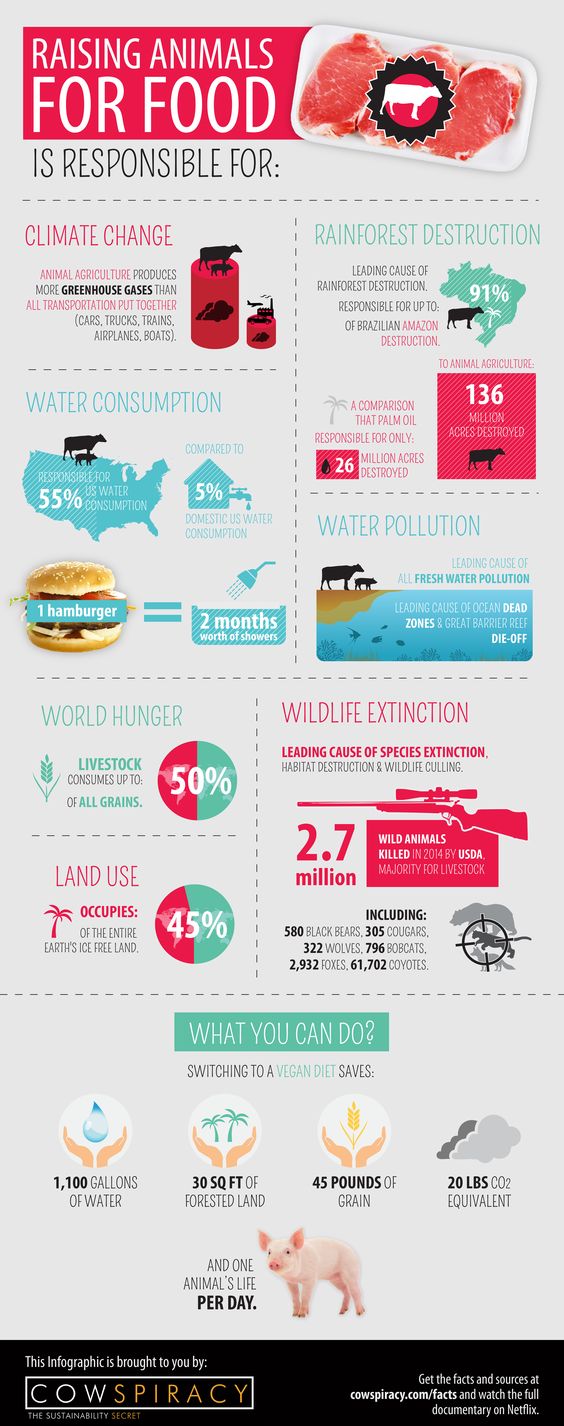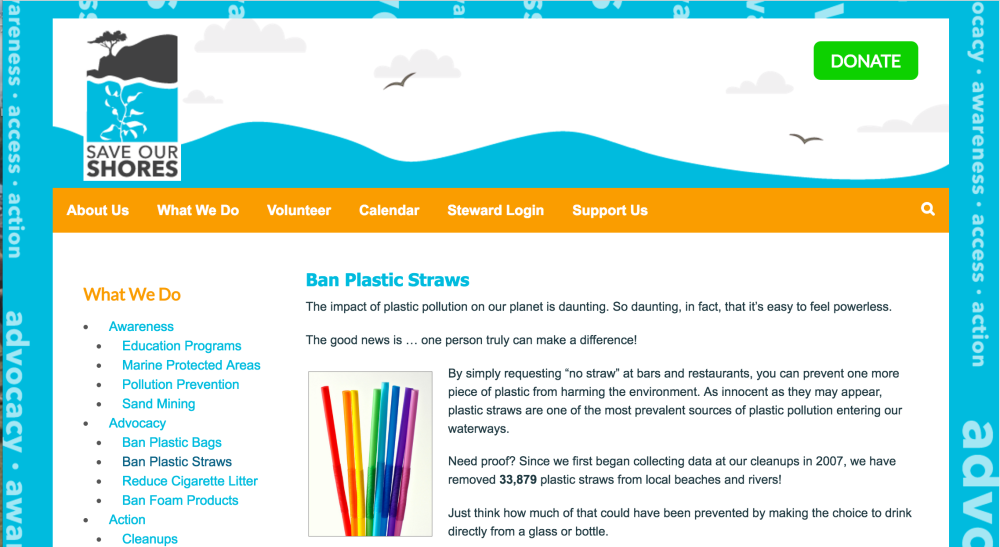



Website: Choose to go straw less

Straw facts:
In the U.S., we use 500 million straws a day! That is enough straw waste to wrap the circumference of the earth 2.5 times
Humans have been using “drinking tubes” for over 7,000 years. Mesopotamians used straws made of reeds or gold to filter beer, and the Chinese used tubes to sip on cloudy rice wine. In Egypt, one inscription shows that straws prevented the accidental slurping up of insects while drinking at night. The Guaraní people of South America drank yerba mate, a caffeine-loaded infusion, with filter straws called bombillas long before the arrival of Spaniards in the 1500s. And, in the 1800s in Europe and North America, dried wheat shafts and rye straws became popular until the invention of the paper straw in 1888.
in more recent history, the United States likely propelled the use of disposable straws. In the early 1900s, when polio and tuberculosis were rampant in the country and people became increasingly afraid of contagious disease from shared glasses, soda fountains began offering drinking straws to prevent contact with the glass.
In the mid-1950s, another boost to the straw industry occurred with the continued popularization of cars. Restaurants—spearheaded by McDonald’s—revolutionized the quick meal by replacing washable glassware with low-cost, disposable packaging for meals and drinks on the go. In the 1960s, plastic replaced paper, shifting straws from a renewable to an oil-based, single-use product.
The problem with straws is one of sheer volume. Although using one straw doesn’t seem like a big deal, Americans alone use an estimated 500 million straws every day, well above one daily for each of the country’s nearly 320 million residents. End to end, straws used daily in the United States could circle the planet more than two-and-a-half times a day.
The demand for disposable foodware is expected to keep rising, driven in part by the continuing consumer desire for convenience. People are eating out more often, consuming more meals on the go, and drinking more specialty drinks. McDonald’s alone provides single-use plastic straws through 36,000 restaurants in over 100 countries. Other fast food restaurants have also mushroomed globally, spreading the throw-away economy.
But there’s a problem with making more plastic straws. More plastic means that we need more oil and gas extraction and more electricity to power the plastic production. Then, of course, we need more gas to ship materials from plastic manufacturers to straw makers, more electricity to power straw-making machines, and more gas (again!) to deliver straws to customers. Ultimately, that means we end up with more carbon emissions and pollution from all of these industrial processes and transport.
On the disposal end, the picture isn’t pretty either. Nearly every piece of plastic ever made, regardless of whether it has been recycled, still exists. And while polypropylene is a versatile plastic, straws are small and hard to pick out when workers sift through recycling, meaning they are rarely recovered.
Between 22 and 43 percent of plastic worldwide is disposed of in landfills, where its resources are wasted, it takes up valuable space, and it blights communities. Plastic also contributes over 250,000 tons of trash (that’s about 570 fully loaded Boeing 747s) to oceans; straws and stirrers are among the top 10 marine plastic debris found during coastal cleanups. Some researchers estimate that 90 percent of individual seabirds, many whales and dolphins, and some sea turtles have ingested plastics, including plastic straws. Ocean plastics eventually break into smaller fragments, where they are carried up the food chain, possibly concentrating toxic chemicals in predators.
1. Straws Rank in the Top 10 for Marine Debris
Constituting more than 90 percent of all trash floating in the world’s oceans, plastic products, in general, are considered to be the most detrimental man-made item in the oceans. When ranking all plastic products, straws never fail to make it onto the Ocean Conservancy’s top 10 most collected items at beach cleanups. In fact, the 2014 list ranked straws as the number five most popular found item behind bottle caps, wrappers, and cigarette butts.
What’s sad about this fact is that while items such as plastic bags can be used over and over again (though most people don’t seem to utilize this fact…), straws are a one-time-use product. Mainly found in restaurants, straws can’t be washed as they can easily melt and leak toxic chemicals onto other dishes. Why even bother to use something if it can only be used once?
2. Petroleum Plastics Last Forever
So plastic is pretty destructive, but what exactly is so bad about it?
Well, since we’re focusing on straws here, let’s talk about what these plastic drinking devices are made of. Straws consist of the petroleum bi-product polypropylene, which is essentially the same stuff that fuels our cars. (And we put that in our mouths? Ew!) This bi-product does not easily degrade naturally in the environment, and ends up floating across the oceans until it is consumed by some aquatic organism.
According to the Plastic Pollution Coalition, “Every bit of plastic that has ever been created still exists, including the small amount that has been incinerated and has become toxic particulate matter.”
In 2012, over 32 million tons of plastic were discarded with most of it ending up in our oceans. These plastics were then either consumed by aquatic organisms or sucked up into oceanic gyres where human waste products accumulate and float as make-shift islands … forever. When plastics, such as straws, do begin to degrade, they release harmful toxins that can pollute aquatic ecosystems and ultimately destroy the environment.
3. Straws are Easily Swept Up Into Gyres
In oceanography, the term “gyre” refers to any large, circular ocean current caused by the combination of the planet’s rotation and Earth’s wind pattern. The circular movement of gyres draws in debris that, eventually, becomes trapped. As more and more debris accumulates, garbage patches form and – seeing as how most oceanic trash is composed of plastics – float forever. You thought Sharknado was terrifying, well the Strawnado is worse.
The most notable garbage patch in the ocean’s today is the Great Pacific Ocean Garbage Patch, which is estimated to be roughly the size of continent. The patch contains about 100 million tons of debris with about 80 percent of that debris originating from products that are used in land-based activities. This indefinitely includes straws used for drinking. When concentrated in such large quantities, the trash collected in the vortex can only break down partially. Once these objects do begin to break down, they leach toxins into the ocean, contaminating marine food chains. With mercury poisoning already soiling your beloved fish, how would you feel if you knew that plastics are now pleasuring your taste buds?
4. Straws and Other Plastics Can Kill Marine Life
Over 1,000,000 seabirds fall victim to plastic consumption annually. In fact, the viral image of the stomach contents of an albatross chick shows the sad and painful result of human errors when it comes to properly disposing (and reusing) items made of plastic. Small straws (such as the ones that accompany juice packets) are often what cause the deaths of sea birds as they can easily be picked up, maneuvered, and swallowed. These straws can then block the airway of birds and cause them to choke.
Birds are not the only victims of plastic consumption. In the North Pacific alone, about 12,000 to 24,000 tons of plastics end up in the digestive systems of fish. While this directly impacts the health of fish, the consumption of plastic products is then transferred into the food chain where animals such as whales, dolphins, and seals are affected. Worldwide, about 100,000 marine mammals unintentionally consume plastic products each year.
Turtles have been observed eating twice as much plastic as they did 25 years ago. Plastic items can easily block a marine reptile’s stomach or even puncture their intestinal walls which ultimately leads to starvation as the digestive system is unable to gain proper nutrients. Furthermore, toxins that are released by partially digested plastics can disrupt an animal’s reproductive system. This has been observed in sea turtles, and since most sea turtles are considered to be endangered, this spells bad news for future populations.
Solutions:
Glass straws – Glass Dharma makes borosilicate glass straws that come in a variety of lengths and diameters.
Strawsome also sells handmade glass straws, made in USA with lifetime guarantee and free US/Canada shipping. They come in different colors, shapes, diameters, and lengths.
Metal straws – Mulled Mind sells made-in-USA stainless straws that are shipped in recycled and reused materials.
Sets of 4 stainless steel straws with a cleaning brush sold by Life Without Plastic.
Bamboo straws – These 10” bamboo straws are entirely unprocessed; they’re just dried hollow stalks that can be washed, air-dried, and used for many years.
Bambu Home sells slightly shorter straws, at 8.5” long. They are made from organic bamboo, harvested from wild groves, rather than plantations, and are finished with an organic flax seed oil.
Paper straws – Paper straws still generate some waste, so they’re not as good as reusable options, but a huge improvement over plastic. You can order from Aardvark Straws (made in USA).
Straw straws – Straws that are made from straw? It’s the most logical material out there. This company has an online store set to open in October 2016, so you’ll be able to place orders shortly.
Pasta straws – It’s the ultimate zero waste solution and kids will love it. Look for bucatini or perciatelli, long spaghetti-like, tube-shaped noodles with holes in the middle, through which it’s possible to sip liquids. Then you can cook your straws and eat them for dinner.
https://www.treehugger.com/green-home/how-banish-plastic-straws-your-life-forever.html
I miss the potato


